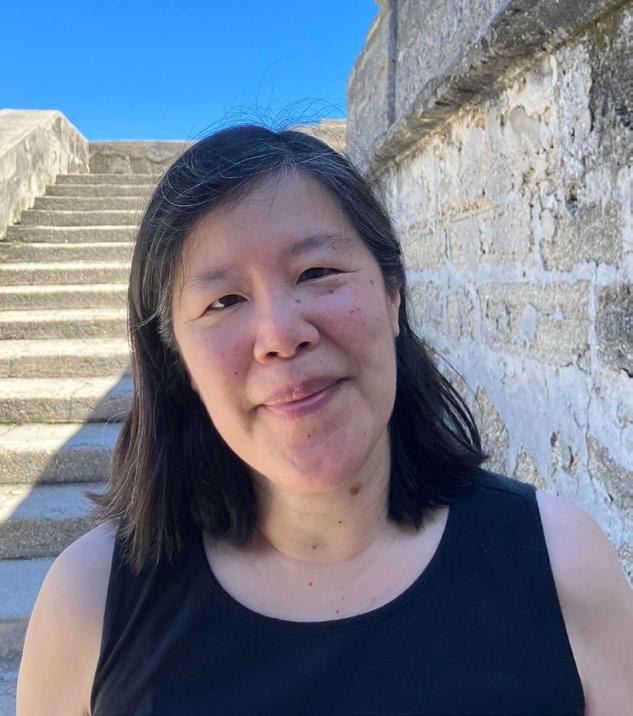
4 minute read
MALAS first year Ivy Chen adds scholarly dimension to career experience in museums
Building on 20 + years of experience in non-profit cultural organizations, Ivy explores a public space’s role in education and community
Who are museums for? This question is one that Ivy Chen (MALAS 2024) thinks about often, as she pursues graduate degrees in Museum Studies and Latin American Studies. Ivy herself feels at home in museums, having grown up regularly visiting them on family trips and weekend excursions.
Advertisement
“A statistic that gets quoted often in arts administration is that museums are seen by the general public as the most trusted places for information,” Ivy explains. “But we forget that museums are incredibly curated spaces.” In adulthood, she found herself on the other side of this information dynamic, as her professional path brought her to arts administration after a B.A. in Asian Studies and an Artist Diploma in Cello Performance at The Boston Conservatory. In her ensuing career, she amassed over 20 years of experience working at non-profit cultural organizations, including eight years at University of Florida’s Harn Museum of Art.
“Even when I worked at a museum, I didn’t fully appreciate how much power museums have,” Ivy says. “There’s no possibility to tell all the stories available, and that means that choices are made. So, whose stories are not being told? Who doesn’t feel welcome in museums, because they don’t feel their culture or community is represented accurately, or even at all?”

Ivy Chen (MALAS 2024) at the Castillo de San Marcos in St. Augustine, Florida
Putting her professional career on pause has afforded Ivy the opportunity to learn more about and reflect on these questions through her studies. Thanks to Dr. Nicholas Vargas’s class Race and Latinxs, Ivy found her way to Latin American Studies and her thesis research project on the Spanish colonial fort Castillo de San Marcos in St. Augustine, Florida. The fort’s origins tell a story of intersecting cultures in early U.S. history: it was constructed in 1695, by free and enslaved Africans as well as Indigenous peoples, to protect Spain’s Atlantic trade against the British and French. The settlement also infringed on Timucua peoples. Today, it’s a popular tourist attraction. Before the pandemic, the Castillo was welcoming approximately 650,000 visitors annually—Ivy was even a chaperone on her daughter’s fourth grade field trip there, a rite of passage for all Florida public school students.
Of particular interest to Ivy is that the Castillo is promoted as an American Latino Heritage Site by the U.S. National Parks Service. “Normally when we think of national parks, we think of places that are preserving beautiful wilderness landscapes,” Ivy explains. “They are also spaces that create an idea of what America is.” But is the Castillo similar for Latino Americans? How does it portray an American identity? Do Hispanic and Latinx American visitors feel a sense of national belonging at the site? These are the questions that Ivy will explore during her fieldwork at the Castillo in the summer of 2023.
Delving into these concepts is a culmination of personal and professional interests for Ivy. One thread traces all the way back to her childhood in Boston—a city whose landmarks tell a story of English colonies and the first sparks of revolt that would lead to U.S. nationhood. There are, too, her own personal reflections on American identity as the daughter of immigrants to the U.S., as well as her motivation to foster community engagement in arts spaces. Her last project at the Harn was the Composers-in-Residence program, which brought UF PhD music composition students to the museum to write a piece of music inspired by an artwork in the collection. “I just thought, what’s a way to connect with people who are more musical and auditory and might not visit an art museum? I always want to connect with visitors in different ways,” Ivy says. She points out that every visitor comes in with their own experiences, and there’s no way to know what they’re going to take away from their visit. But this only affirms her drive to open up museums for different audiences. “That’s part of why I’m doing this research. I want to learn more about this community that the Castillo is trying to engage with, because that’s important. You have to know what that community thinks and how they feel.”
For Ivy, pursuing two graduate degrees mid-career means that she’ll return to her professional endeavors with more qualification for leadership positions in arts administration. More than that, she’ll have the results of a unique opportunity to explore new dimensions of her chosen field: “I feel really thankful that I’ve had this chance to come back to school and have the time to really read and engage and think more deeply about these issues.” ◆










